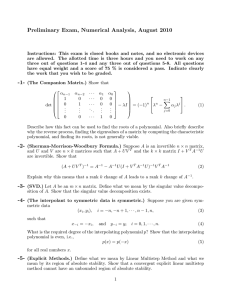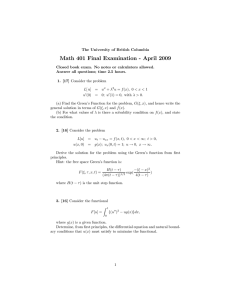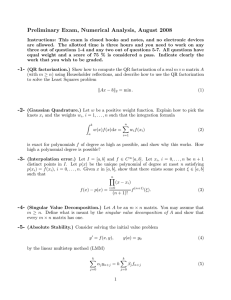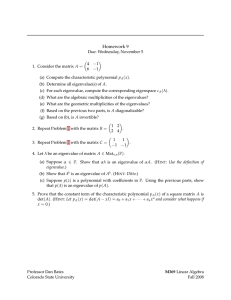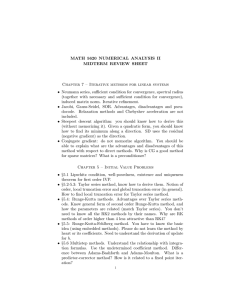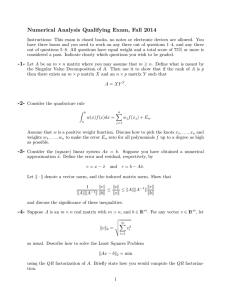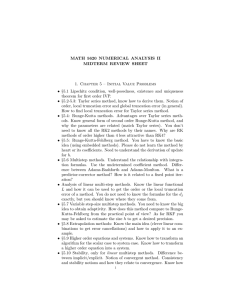Preliminary Exam, Numerical Analysis, January 2009
advertisement
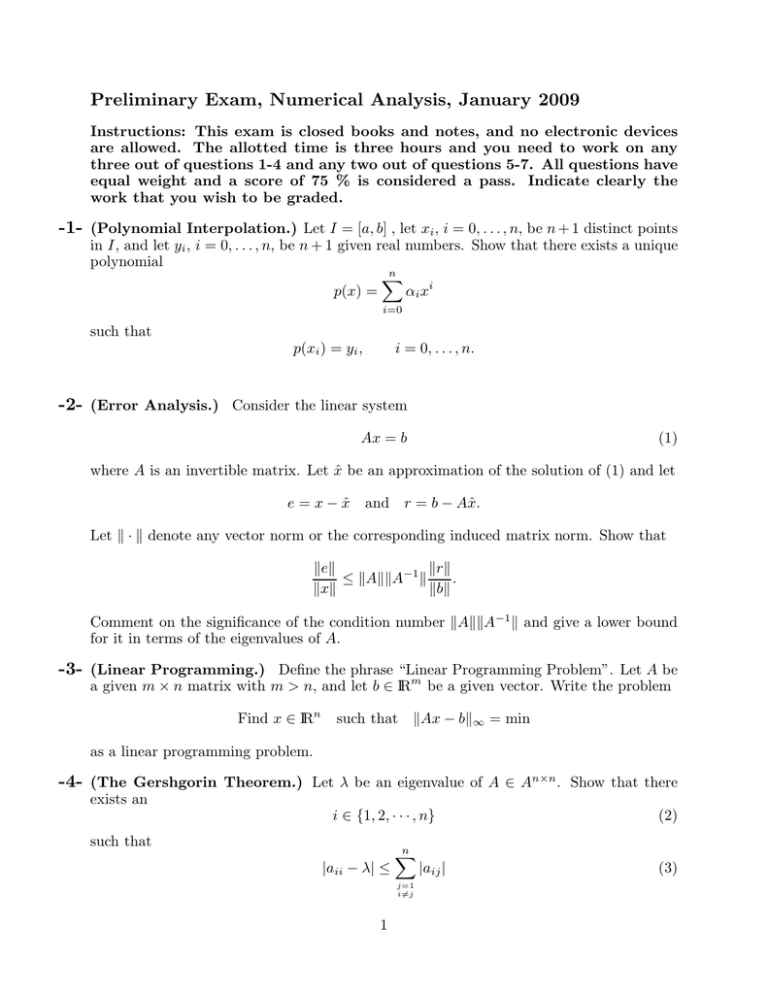
Preliminary Exam, Numerical Analysis, January 2009
Instructions: This exam is closed books and notes, and no electronic devices
are allowed. The allotted time is three hours and you need to work on any
three out of questions 1-4 and any two out of questions 5-7. All questions have
equal weight and a score of 75 % is considered a pass. Indicate clearly the
work that you wish to be graded.
-1- (Polynomial Interpolation.) Let I = [a, b] , let xi , i = 0, . . . , n, be n + 1 distinct points
in I, and let yi , i = 0, . . . , n, be n + 1 given real numbers. Show that there exists a unique
polynomial
n
!
p(x) =
α i xi
i=0
such that
p(xi ) = yi ,
i = 0, . . . , n.
-2- (Error Analysis.) Consider the linear system
Ax = b
(1)
where A is an invertible matrix. Let x̂ be an approximation of the solution of (1) and let
e = x − x̂
and r = b − Ax̂.
Let " · " denote any vector norm or the corresponding induced matrix norm. Show that
"e"
"r"
≤ "A""A−1 "
.
"x"
"b"
Comment on the significance of the condition number "A""A−1 " and give a lower bound
for it in terms of the eigenvalues of A.
-3- (Linear Programming.) Define the phrase “Linear Programming Problem”. Let A be
a given m × n matrix with m > n, and let b ∈ IRm be a given vector. Write the problem
Find x ∈ IRn
such that "Ax − b"∞ = min
as a linear programming problem.
-4- (The Gershgorin Theorem.) Let λ be an eigenvalue of A ∈ An×n . Show that there
exists an
i ∈ {1, 2, · · · , n}
such that
|aii − λ| ≤
n
!
j=1
i!=j
1
|aij |
(2)
(3)
For every eigenvalue λ, the inequality (3) describes a circle in the complex plane called
a Gershgorin circle. Let S be a set that is the union of k ≤ n Gershgorin circles such
that the intersection of S with all other Gershgorin circles is empty. Show that S contains
precisely k eigenvalues of A (counting multiplicities). Without proof or counterproof state
whether it is possible for a Gershgorin Circle not to contain any eigenvalue at all.
-5- (Adaptive Quadrature.) Describe the basic idea of adaptive quadrature, and give a
simple example, including formulas.
-6- (Linear Multistep Methods.) Consider the initial value problem
y $ = f (x, y),
y(a) = y0
Let h be some stepsize, xn = a + nh, yn ≈ y(xn ), and fn = f (xn , yn ), for n = 0, 1, 2, 3, . . ..
Let k be some step number, and ignore the question of obtaining starting values y1 , y2 ,
. . . , yk−1 . Suppose the approximations yn , n = k, k + 1, . . . are obtained by the Linear
Multistep Method
k
k
!
!
βj fn+j .
(4)
αj yn+j = h
j=0
j=0
Define what is meant by the local truncation error and the order of the linear multistep
method (4). Compute the order and the local truncation error of Euler’s Method
yn+1 − yn = hfn .
(5)
-7- (Numerical PDEs.) Consider the one-dimensional heat equation: Find u(x, t) such that
ut = uxx ,
t ≥ 0,
x ∈ [0, 1],
u(x, 0) = f (x),
u(0, t) = u(1, t) = 0.
Describe how this problem might be solved by applying the Method of Lines and Euler’s
Method. Give formulas that could be used to write a suitable computer code.
2
